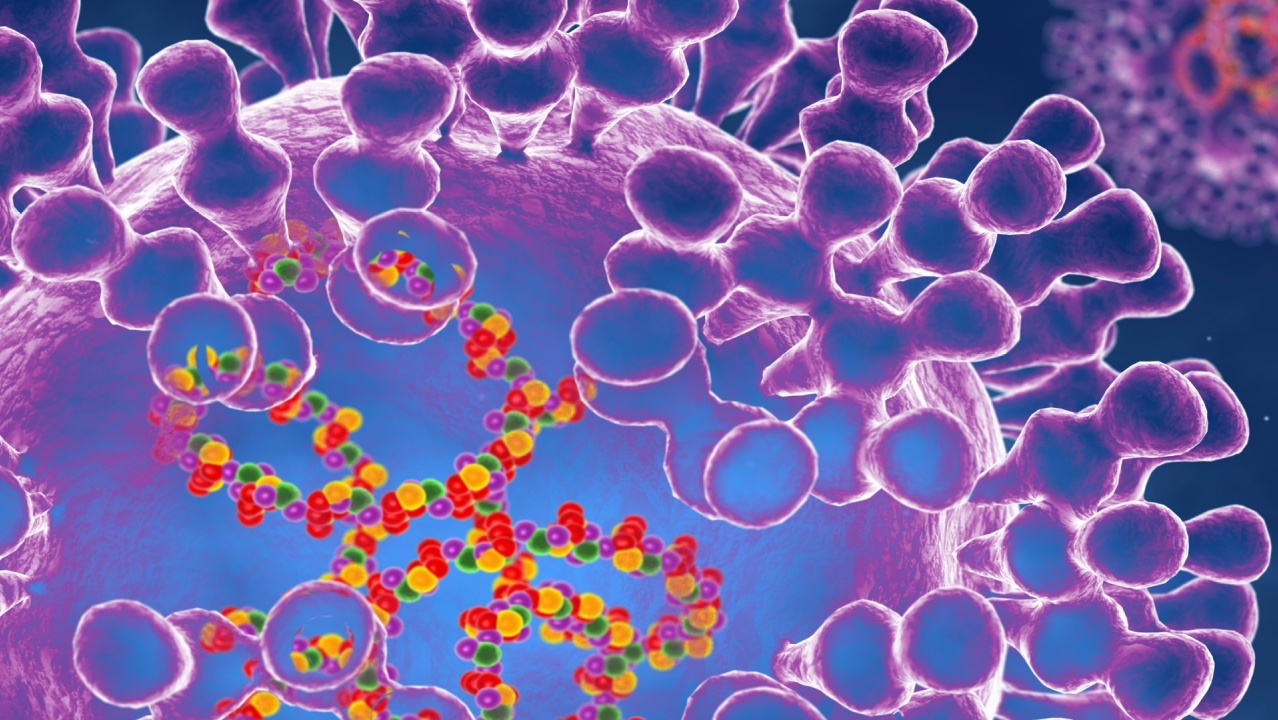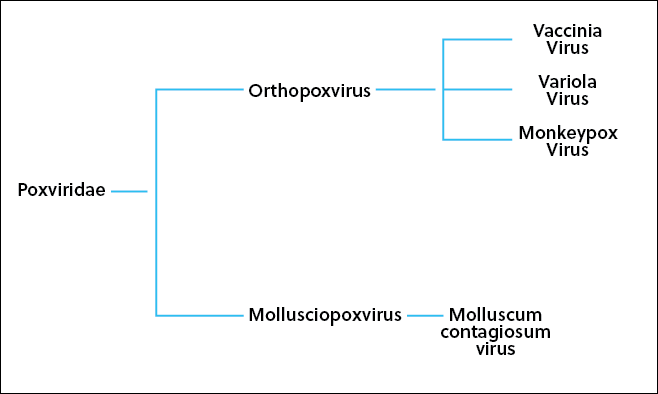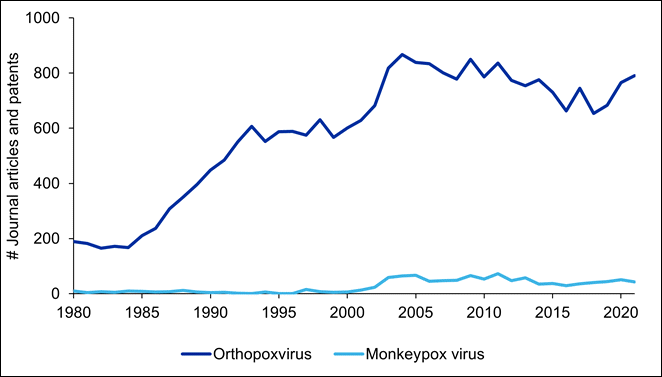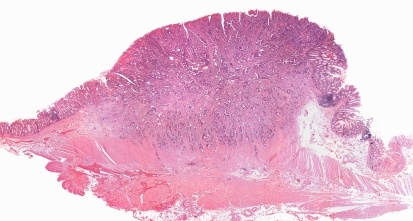Gain new perspectives for faster progress directly to your inbox.

With heightened viral awareness due to the COVID-19 pandemic, the news of monkeypox outbreaks around the world is raising many red flags. Monkeypox is a virus that is regularly found and confined to Central and West Africa. It has spread in unusual ways with this outbreak and amongst populations that have not been vulnerable in the past. Currently there are over 300 confirmed or suspected cases in at least 19 countries outside of Africa with many more under investigation. The CAS Content Collection™ enables unique insights on monkeypox, the research landscape, therapeutic options, and scientific profiles with similar viruses.
What is Monkeypox?
Monkeypox virus is classified in the family Poxviridae with the genus Orthopoxvirus. The CAS Content Collection shows the phylogeny of the monkeypox virus. It is within the same family as a common childhood skin disease Molluscum contagiosum and within the same genus as viruses such as the vaccinia virus (cowpox virus) and the variola virus (smallpox virus). It is not however related to the commonly known chicken pox virus (Varicella). It was first discovered in 1958 in colonies of research monkeys that developed a pox-like disease, with the first human case reported in the Democratic Republic of the Congo (DRC) in 1970. All subsequent cases outside of endemic countries have been limited to travel from these countries or infected imported animals. Monkeypox is classified as a zoonotic disease with transmission being primarily from animal to human or vice versa. This current outbreak however has shifted to human-to-human transmission in non-endemic countries, baffling many and bringing this rare disease to the headlines.

Landscape view of the published science on monkeypox
Analyzing the CAS Content Collection, research for Orthopoxvirus started to increase during the late 1980s with 30,000 journal articles and patents present under this category. As expected, the publication volume for monkeypox is much smaller with around 1200 journal articles and patents, with research increasing slightly in the early 2000s, and remaining relatively stable from 2003 through 2021.

Table 1. Top 10 Companies and Research Institutes researching the monkeypox virus
| Company or Research Institute | Number of Articles and Patents |
| National Institutes of Health (USA) |
38 |
| Centers for Disease Control and Prevention | 35 |
| United States Army Medical Research Institute of Infectious Diseases | 26 |
| Saint Louis University | 14 |
| Robert Koch Institute | 9 |
| Oregon Health and Science University | 7 |
| Southern Illinois University | 7 |
| Chimerix Inc. | 6 |
| La Jolla Institute for Immunology | 6 |
| Utah State University | 6 |
How is monkeypox transmitted?
Monkeypox virus is a double‐stranded DNA (dsDNA) virus with a genome size of around 190 kb. In contrast to SARS-CoV-2 which is a single stranded RNA virus with a genome size of ≈30 kb. As we know all too well, SARS-CoV-2 is so small that it can be aerosolized and travel over 6 feet in the air. Monkeypox virus in contrast is much larger in size, it does not aerosolize, and travels only a few feet before dropping in the air. The Monkeypox virus also does not linger in the air as the SARS-CoV-2 virus does. For human-to-human transmission through air, it takes prolonged face to face contact with an infected individual. It can also be spread through direct contact with body fluids or lesions or indirect exposure to lesion material such as through clothes or bedding. Animal-to-human transmission can occur by bite or scratch, bush meat preparation, and direct or indirect contact with body fluids or lesions. The virus enters the body through broken skin, the respiratory tract, or mucous membranes. Another positive contrast from the SARS-CoV-2 virus is that the Monkeypox virus mutates at a much slower rate, given that it is a DNA virus with a much larger size. Which makes historical and current vaccines highly effective.
Genetic profiles of current monkeypox
DNA viruses are usually stable and mutate extremely slowly compared to RNA viruses. Researchers from Portugal shared the first draft genome on May 19, 2022 and released an additional nine genome sequences of the Monkeypox virus that is causing the current multi-country outbreak on May 23. The current preliminary draft of genomic sequencing shows the current outbreak belongs to the standard West African strain and is closely related to the monkeypox strain that was associated with animal exportation from Nigeria to several countries in 2018 and 2019. Researchers observed that the current outbreak most likely came from a single origin, but also diverged from the 2018/2019 sequence with 50 small nucleic acid polymorphisms (SNP). They also discovered the first signs of microevolution within this outbreak cluster, with the emergence of 7 SNPs leading to the creation of 3 decedent branches which included a further subcluster of 2 sequences. This two sequence subcluster was determined to have a 913bp frameshift deletion which appears to correlate to human-to-human transmission. This microevolution may allow this genome sequence to have enough resolution to track the virus dissemination with this outbreak, which is often not possible with other dsDNA viruses.

Vaccinations and Possible Monkeypox treatments
While vaccines are not immediately available to the general public, the US government is currently releasing JYNNEOS vaccines from the nation’s strategic national stockpile for some high-risk contacts of early patients. Current vaccinations and possible treatments are summarized and shown below in Table 2.
Table 2. Monkeypox vaccine and possible treatments.
| Name and CAS Registry Number | Notes |
| Vaccinations | |
| JYNNEOS (Imvamune/ Imvanex) * 1026718-04-6 |
Licensed in the US to prevent monkeypox and smallpox. At least 85% effectiveness in preventing monkeypox. |
| ACAM2000* 860435-78-5 |
Can be used in people exposed to monkeypox if used under an expanded access investigational new drug (IND)protocol. Is licensed for immunization in people who are at least 18 years old and at high risk for smallpox infection. |
| Possible Treatments | |
| Cidofovir 113852-37-2 |
Proven activity against poxviruses based on in vitro and animal studies. Adverse effect of renal toxicity. |
| Brincidofovir (CMX001) 444805-28-1 |
Proven activity against poxviruses based on in vitro and animal studies. Improved safety profile over Cidofovir. |
| Tecovirimat (ST-246) 869572-92-9 |
Studies using animals have shown effectiveness in treating orthopoxvirus-induced disease. Human clinical trials indicated safety and tolerability with only minor side effects. Although currently stockpiled by the Strategic National Stockpile, use is only available under a IND. |
| Vaccinia Immune Globulin (VIG) | The usse of VIG is administered under an IND and has no proven benefit in the treatment of smallpox complications. VIG can be considered for prophylactic use in an exposed person with severe immunodeficiency in T-cell function for which smallpox vaccination following exposure to monkeypox is contraindicated. |
Outlook
With the World Health Organization announcing the eradication of smallpox in 1980, the smallpox eradication program ended worldwide. As with any vaccination, immunity wanes over time and anyone born after 1980 did not receive the smallpox vaccination and therefore is not protected from the monkeypox virus. Research shows that 30 years after the smallpox vaccination campaigns ended in the DRC, there was a major increase in the incidence of human monkeypox infections. This along with less research on monkeypox may seem troubling to some but there has been extensive research on other viruses within the same family. Vaccination, treatment options, along with less transmissibility all point to a controllable situation for this current outbreak that should minimize global impact. All cases of the outbreak have not been identified yet but with the viral awareness and public health prevention measures, the monkeypox virus should stop spreading amongst non-endemic countries.



